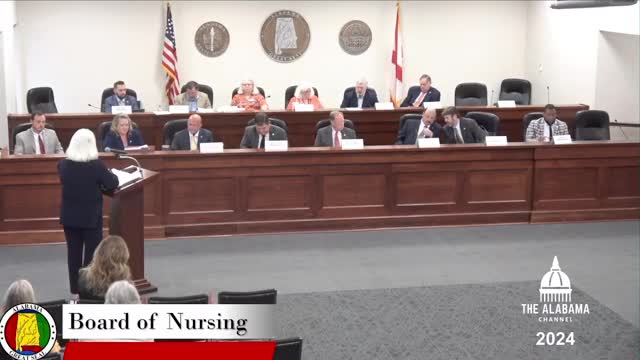Nursing program tackles workforce shortages with innovative solutions
September 26, 2024 | Joint Interim Committees, Alabama Legislative Sessions, Alabama
This article was created by AI summarizing key points discussed. AI makes mistakes, so for full details and context, please refer to the video of the full meeting. Please report any errors so we can fix them. Report an error »

In a recent government meeting, officials discussed the ongoing challenges and initiatives within the nursing profession, particularly focusing on workforce development and compliance programs for nurses recovering from substance abuse.
Currently, approximately 70 nurses enter a compliance program each year, which monitors around 500 nurses for adherence to treatment protocols. Nurses typically remain in the program for three to five years, during which they can work, provided they meet specific requirements, including regular drug screenings and counseling. The program aims to ensure that nurses are safe to return to practice, with neuropsychological testing employed to assess their readiness.
The meeting also highlighted the critical nursing shortage affecting the state and the nation. To address this, officials discussed various scholarship and loan repayment programs funded by the Education Treasury. These initiatives, totaling around $600,000 annually, aim to increase the nursing workforce by supporting individuals pursuing nursing education and advanced practice roles.
Three key funding programs were outlined: one for nursing educators seeking advanced degrees, another for advanced practice nurses willing to work in underserved areas, and a new initiative aimed at filling nursing faculty vacancies in public colleges. The latter is particularly urgent, as the state faces a significant shortage of nursing faculty, leading to thousands of nursing students being turned away each year due to lack of available instructors.
Despite the funding efforts, officials noted that demand often exceeds supply. For instance, this year, 120 applicants sought advanced practice loan repayments, but only 33 could be supported. The meeting underscored the need for increased funding and strategic planning to effectively utilize available resources and address the nursing workforce crisis.
Additionally, discussions touched on the importance of maintaining adequate financial reserves to ensure the sustainability of these programs. Officials emphasized the necessity of having a financial cushion to manage operational costs, particularly in light of recent challenges faced by the massage therapy sector.
Overall, the meeting reflected a commitment to enhancing the nursing profession through targeted support and strategic resource management, while acknowledging the pressing need for more robust solutions to the ongoing workforce shortages.
Currently, approximately 70 nurses enter a compliance program each year, which monitors around 500 nurses for adherence to treatment protocols. Nurses typically remain in the program for three to five years, during which they can work, provided they meet specific requirements, including regular drug screenings and counseling. The program aims to ensure that nurses are safe to return to practice, with neuropsychological testing employed to assess their readiness.
The meeting also highlighted the critical nursing shortage affecting the state and the nation. To address this, officials discussed various scholarship and loan repayment programs funded by the Education Treasury. These initiatives, totaling around $600,000 annually, aim to increase the nursing workforce by supporting individuals pursuing nursing education and advanced practice roles.
Three key funding programs were outlined: one for nursing educators seeking advanced degrees, another for advanced practice nurses willing to work in underserved areas, and a new initiative aimed at filling nursing faculty vacancies in public colleges. The latter is particularly urgent, as the state faces a significant shortage of nursing faculty, leading to thousands of nursing students being turned away each year due to lack of available instructors.
Despite the funding efforts, officials noted that demand often exceeds supply. For instance, this year, 120 applicants sought advanced practice loan repayments, but only 33 could be supported. The meeting underscored the need for increased funding and strategic planning to effectively utilize available resources and address the nursing workforce crisis.
Additionally, discussions touched on the importance of maintaining adequate financial reserves to ensure the sustainability of these programs. Officials emphasized the necessity of having a financial cushion to manage operational costs, particularly in light of recent challenges faced by the massage therapy sector.
Overall, the meeting reflected a commitment to enhancing the nursing profession through targeted support and strategic resource management, while acknowledging the pressing need for more robust solutions to the ongoing workforce shortages.
View full meeting
This article is based on a recent meeting—watch the full video and explore the complete transcript for deeper insights into the discussion.
View full meeting
